Easy urbexing on the Dalmatian Coast at the bay of abandoned hotels
The words ‘urbexing’ and ‘easy’ are a rare combination but the smattering of abandoned hotels near the Croatian seaside town of Kupari is not only one of the best places for a spot of urban exploration along the southern Dalmatian coastline, they are also currently one of the most accessible. As of September 2018, when we visited the area, it was possible to go inside and explore each of the five properties that overlook the pretty stretch of beach, a short distance from the town itself.
Just under 10km from Dubrovnik’s historic old town but a million miles away in terms of tourists and popularity, Župa Bay, as it is known, began life as a beach resort in the interwar years (the period between the end of World War I and the beginning of World War II) when, in 1920, a Czech investor constructed the Hotel Grand, a 139-bed property that has the accolade of being the first hotel to be built in the Dubrovnik area.
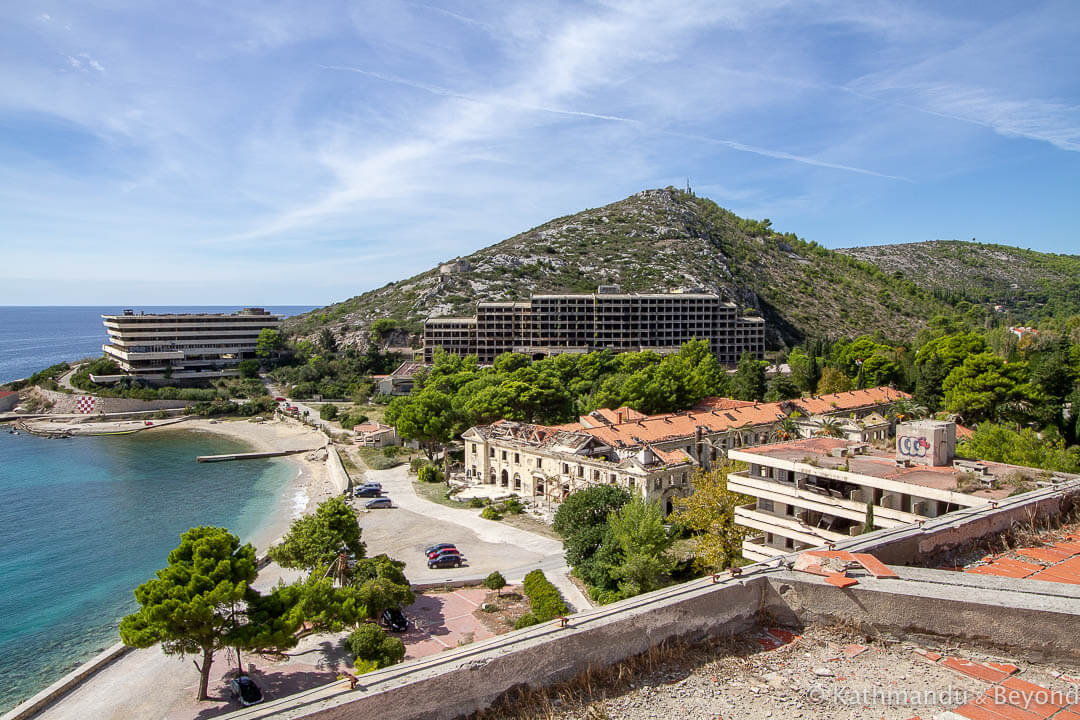 Looking down on Župa Bay (clockwise: Hotel Pelegrin, Hotel Kupari, Hotel Grand and Hotel Goričina I. Photo taken from the roof of Hotel Goričina II)
Looking down on Župa Bay (clockwise: Hotel Pelegrin, Hotel Kupari, Hotel Grand and Hotel Goričina I. Photo taken from the roof of Hotel Goričina II)
The history of Kupari
More on the Hotel Grand itself later but, in the meantime, as time progressed, the obvious attractions of Kupari and Župa Bay came to the attention of the Yugoslav People’s Army (also called the Yugoslav National Army or JNA for short), including its Commander-in-Chief, Josip Broz Tito. He had previously stayed at the Hotel Grand and, along with the top brass, was keen to expand the area as a holiday destination. As a result, during the early part of the 1960s, a second hotel, and then a third, in the form of Hotel Goričina I (1962) and Hotel Pelegrin (1963) respectively was also constructed in the bay. A few years later, in 1978, the Hotel Kupari was added next to Hotel Pelegrin and Hotel Goričina II was more or less built as an extension to the original Goričina I in 1980.
Other hotels, villas and holiday homes were also erected in the area but these are the four that can be seen within the immediate vicinity of the Hotel Grand.
All of the above was done with a sizeable chunk of armed forces funding and, as a result, the place became an upmarket resort for the Yugoslavian military elite and their families (*).
(*) Kupari wasn’t officially just for holidaying military personnel but, without the right connections, taking a vacation there was very difficult if you were a civilian.
At its height, the hotels could accommodate in the region of 2,000 guests, while the surrounding campsite, which was presumably for those who were still in the armed forces but not elite enough to get a room at one of the resorts, would accommodate double that again.
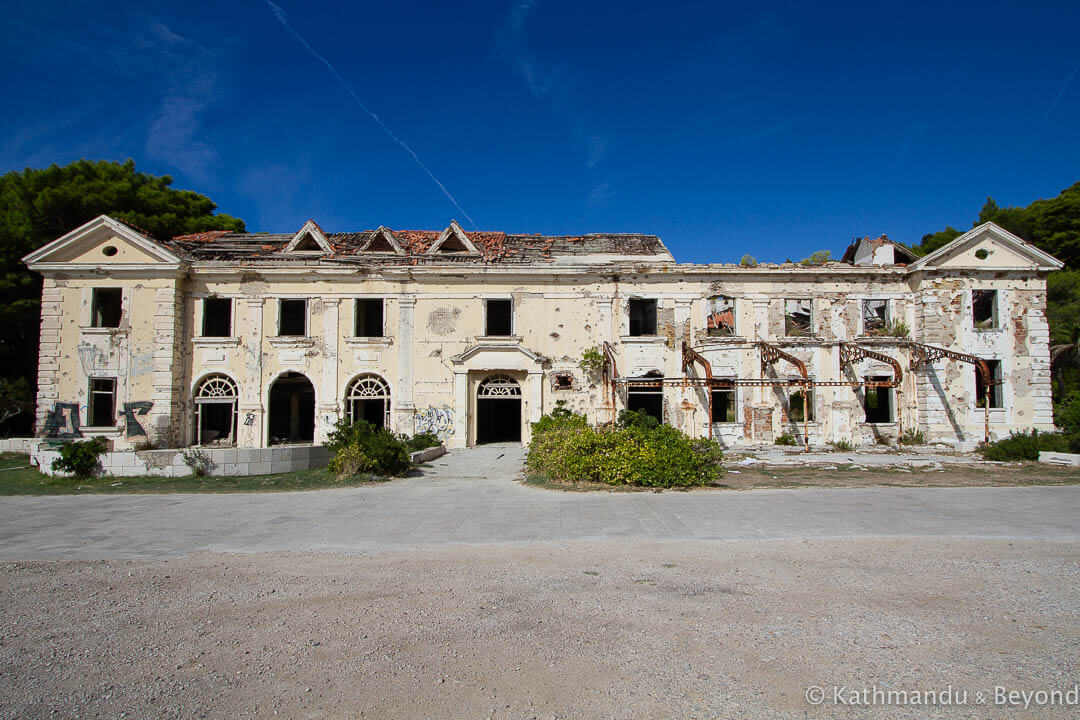 The facade of the Grand Hotel, the oldest property in Župa Bay
The facade of the Grand Hotel, the oldest property in Župa Bay
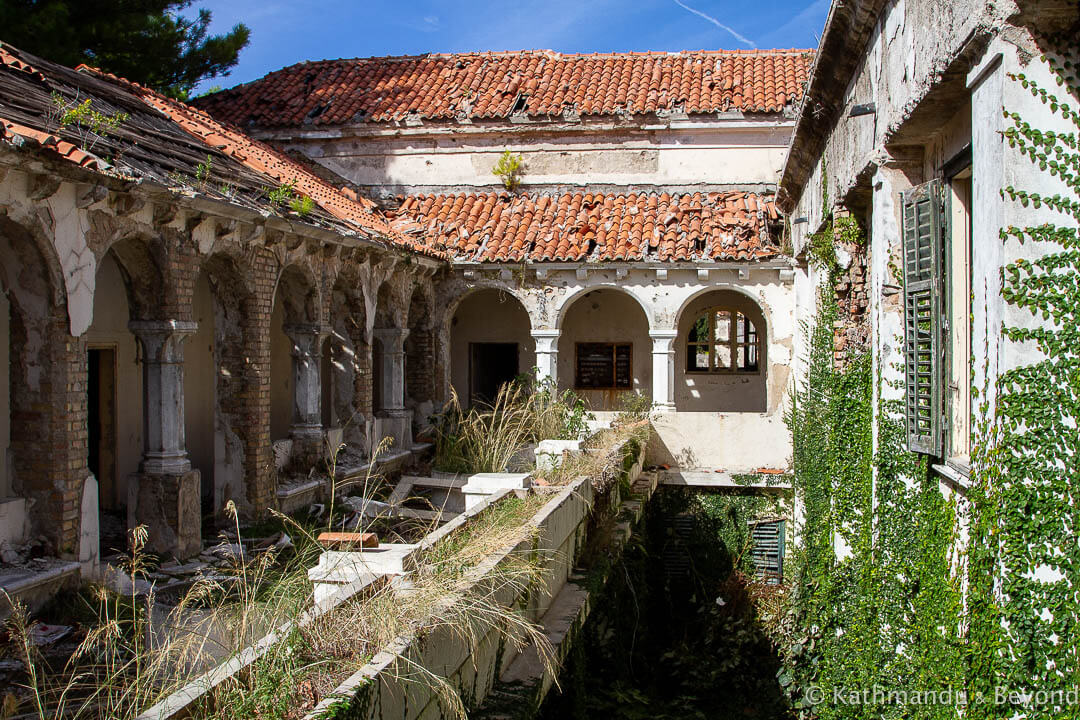 Internal courtyard inside the Grand Hotel
Internal courtyard inside the Grand Hotel
If you know your history of this part of the world, or indeed have read any of our other blog posts about the former Yugoslavia, you’ll probably be aware of why this once extremely-popular vacation spot transformed into the hotel graveyard that can be seen today.
Like the Political School Josip Broz Tito in Kumrovec, the Bay of Hotels, as it is sometimes called, at Kupari was a casualty of the Croatian War of Independence (part of the Yugoslav Wars) which took place between March 1991 and November 1995.
Not long after the start of the war, in early October 1991, the JNA attacked the city of Dubrovnik. The Siege of Dubrovnik, as it became known, lasted until May 1992 and during the early part of the conflict a small band of Croatian soldiers holed up in the hotels in Kupari. The assault on Dubrovnik and the surrounding vicinity included a naval blockade and in an ironic twist of fate, the JNA ended up relentlessly shelling the resort that they had helped create in the first place. It took them just under three weeks to flush out the Croatian soldiers and recapture the bay and after they had accomplished their mission, for some reason, they proceeded to systematically loot the properties of anything of value and then gutted each of them by using bombs made of phosphorus.
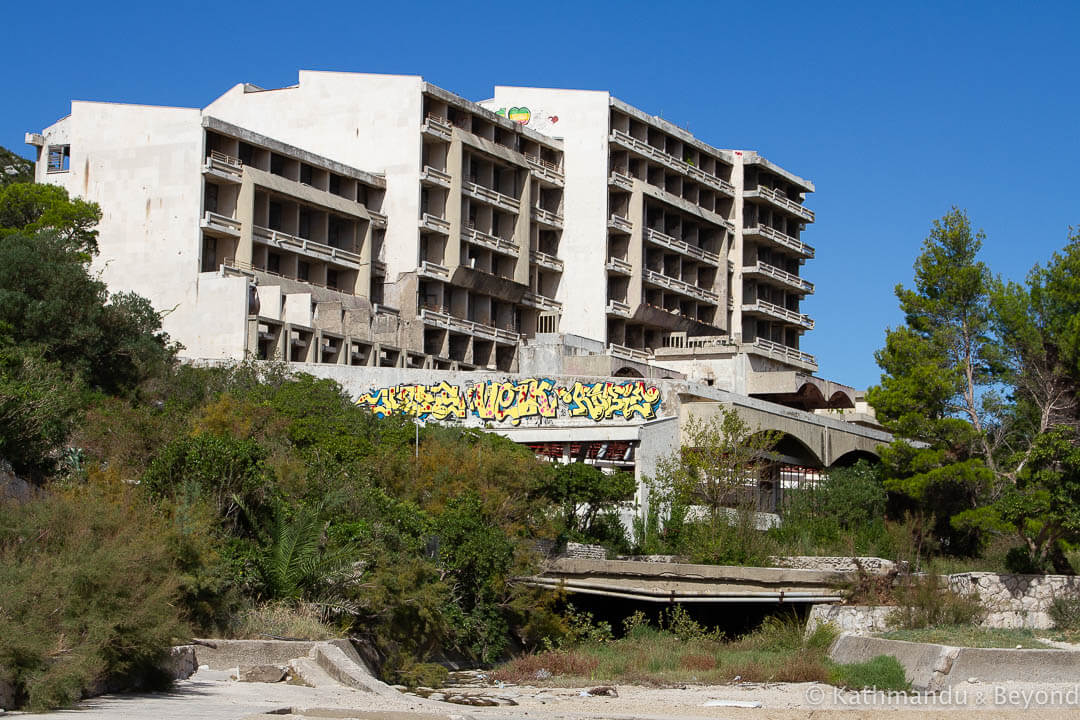 The brutalist exterior of Hotel Kupari
The brutalist exterior of Hotel Kupari
Adhering to guidelines laid down by UNESCO, Dubrovnik’s Old Town was meticulously restored after the war. The city is one of the most, if not the most, popular spots in the former Yugoslavia and the tourists, too many for my liking, visit in their droves. But, despite its close proximity to the ‘Pearl of the Adriatic’ (a reference to Dubrovnik once made by Lord Byron), Kupari’s Župa Bay remains off most tourists’ radar. Probably more people see it from the sea while enjoying a short cruise along the coastline than actually set foot in the place itself and, for the time being, the hotels that encompass Župa Bay continue to crumble and decay, and the beach itself remains relatively free of visitors.
But, for how long …?
Kupari redevelopment
The grounds on which the resorts are situated is prime real estate and, with the number of tourists visiting Dubrovnik increasing year on year, the city could certainly do with the extra hotel beds. The land has been in private hands since 2001 and, according to this series of articles, the latest being dated June 2018, numerous big-name investors have been interested in acquiring it and redeveloping it into an upmarket resort once more. Ritz Carlton (a subsidiary of Marriott International) has been linked with the development project in the past and the latest company to be associated with the bay is the luxury hotel brand, Four Seasons. You can read more about Kupari’s future by clicking on the link above and scrolling through the articles but, in short, it looks as if whoever does ultimately redevelop the area will do two things for certain if they can.
Firstly, and this is the good news, it is highly likely the developer will attempt to keep the original facade of the Hotel Grand and have it as the new resort’s centrepiece. The Grand is by far the most attractive of the remaining properties in the bay and for any hotel company worth its salt, the idea makes perfect sense. But, on the flip side, it’s highly likely that the remaining hotels, all of which can be broadly described as being either modernist or brutalist in style, will be demolished completely in order to make way for new structures that would be built from scratch. Personally, I’m a huge fan of this particular type of architecture but, reluctantly, and given the awful state the other four properties are in, I have to agree that this is the most sensible thing to do from a developer’s point of view.
The other thing that is glaringly obvious is that the clock is ticking for Župa Bay when it comes to its status as the southern Adriatic’s premier urban playground (*).
(*) We do know of another one further south in Montenegro but we haven’t written about that yet!
When we visited in September 2018, there no security personnel to be seen and we could access anywhere we wanted but, when a deal is finally brokered and work begins on the redevelopment program, there will most certainly be security in place, lots of it, and gaining access is likely to be a lot more challenging (and illegal). And even if it is feasible to get within the grounds, there’s a good chance that the majority of the hotels will be in the throes of either being demolished or already gone and there will be nothing left to see.
If you want to explore Croatia’s best-known abandoned sites yourself, my advice would be to do so sooner rather than later.
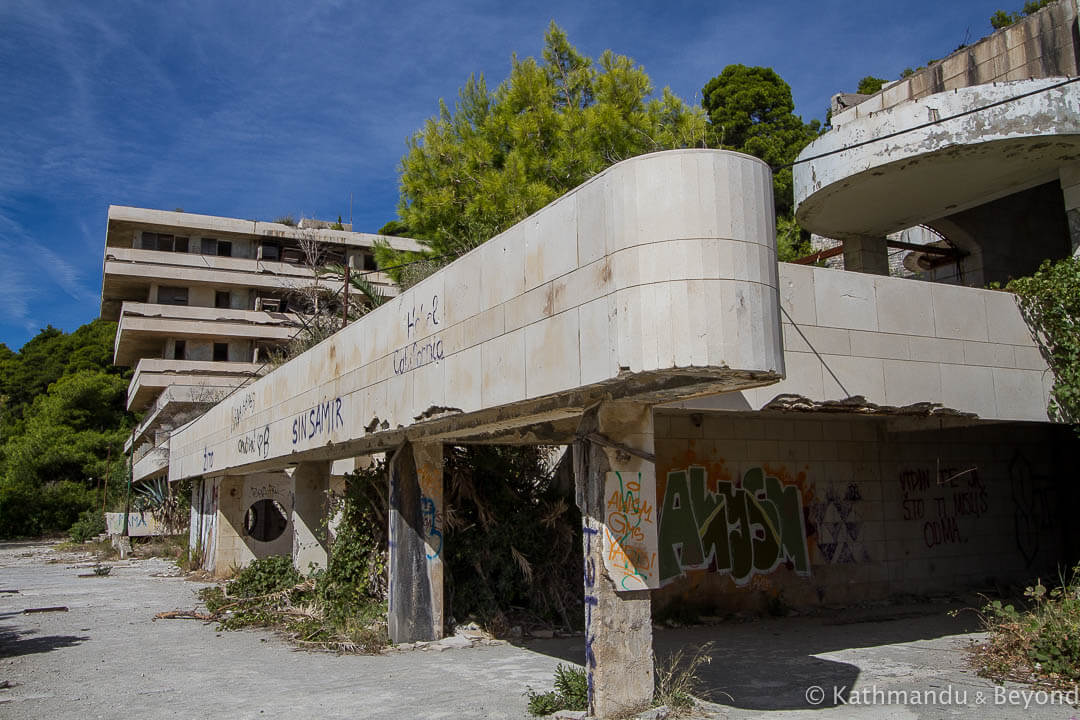 The entrance to Hotel Goričina II with Goričina I in the background
The entrance to Hotel Goričina II with Goričina I in the background
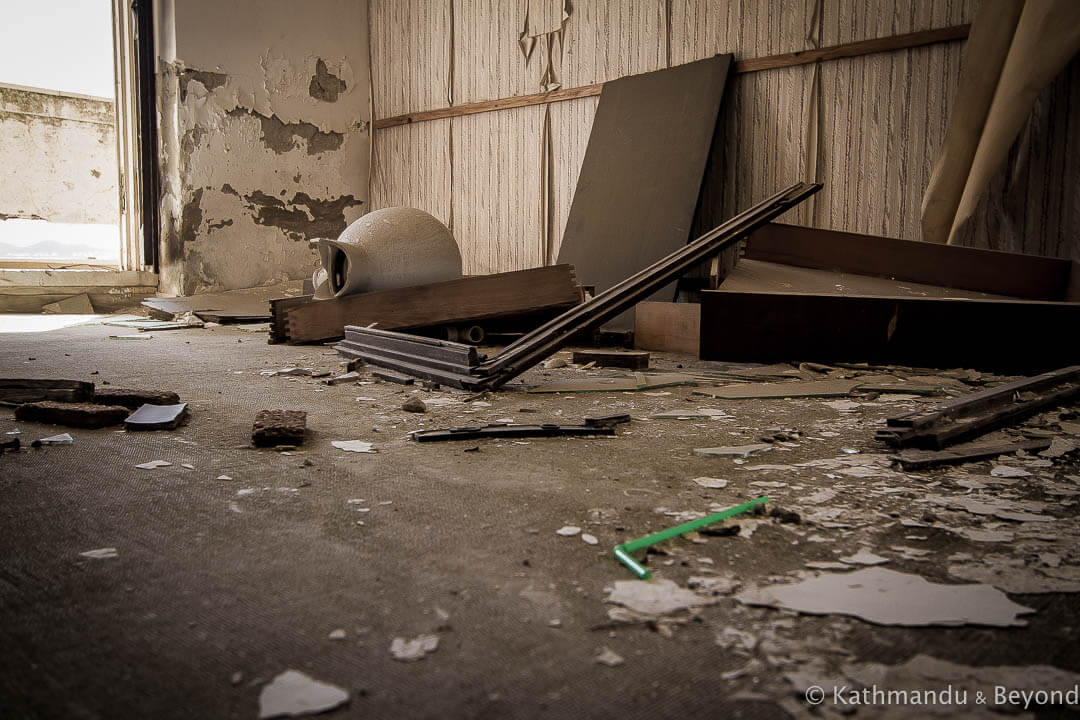
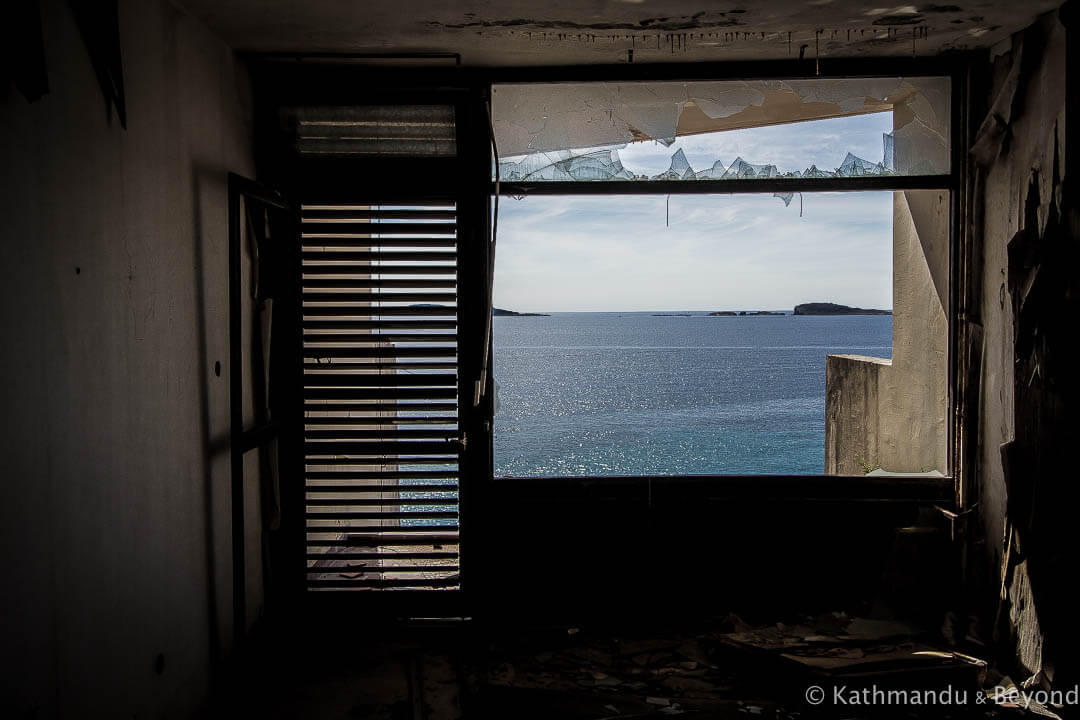
Bedrooms inside Hotel Goričina I (left) and Hotel Goričina II (right)
Our visit to the Bay of Abandoned Hotels in Kupari
We started our exploration of Kupari by first entering the Hotel Pelegrin. Designed by a then-young Sarajevo-based architect named David Finci, this modernist-style hotel looked more impressive from a distance (especially from the roof of the Hotel Goričina II) than it did close up.
This particular hotel was shelled a particularly high number of times during the Siege of Dubrovnik, and it shows. Each of the floors was totally gutted and the courtyard was overgrown with foliage.
It’s also interesting to note that, although this property was originally built for the JNA in 1978, by the early 1980s it was welcoming foreign tourists also. I’m guessing this was a bid by the military to recoup some of the money they had invested into the resort in the first instance. What’s more, I’m also assuming that many of the overseas visitors to arrive during that period would have been from the UK because, after Spain, Yugoslavia was the second most popular overseas holiday destination for the British at that time.
A covered walkway, partly adorned with graffiti, links the Hotel Pelegrin with its neighbouring property, the Hotel Kupari. One of the biggest hotels in the Bay, the undisputed highlight here was the Olympic-sized swimming pool, which would have been magnificent in its day but is now in a wretched state and full of debris.
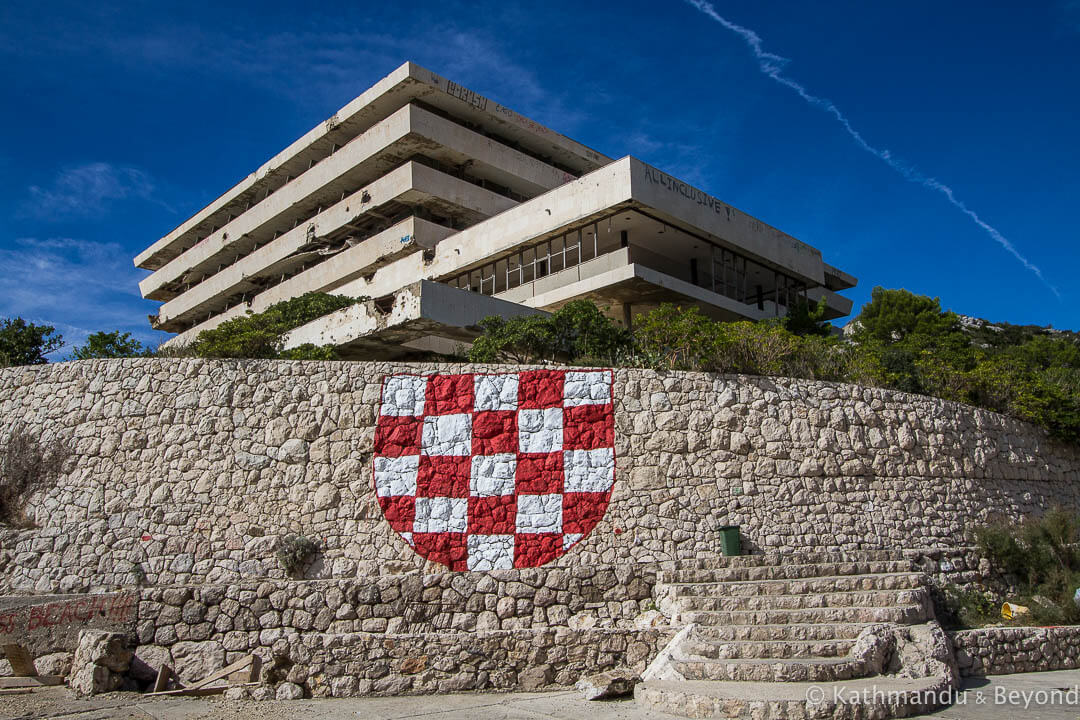 The modernist exterior of the Hotel Pelegrin, which bagged the designer, David Finci, several architectural awards in the 1960s
The modernist exterior of the Hotel Pelegrin, which bagged the designer, David Finci, several architectural awards in the 1960s
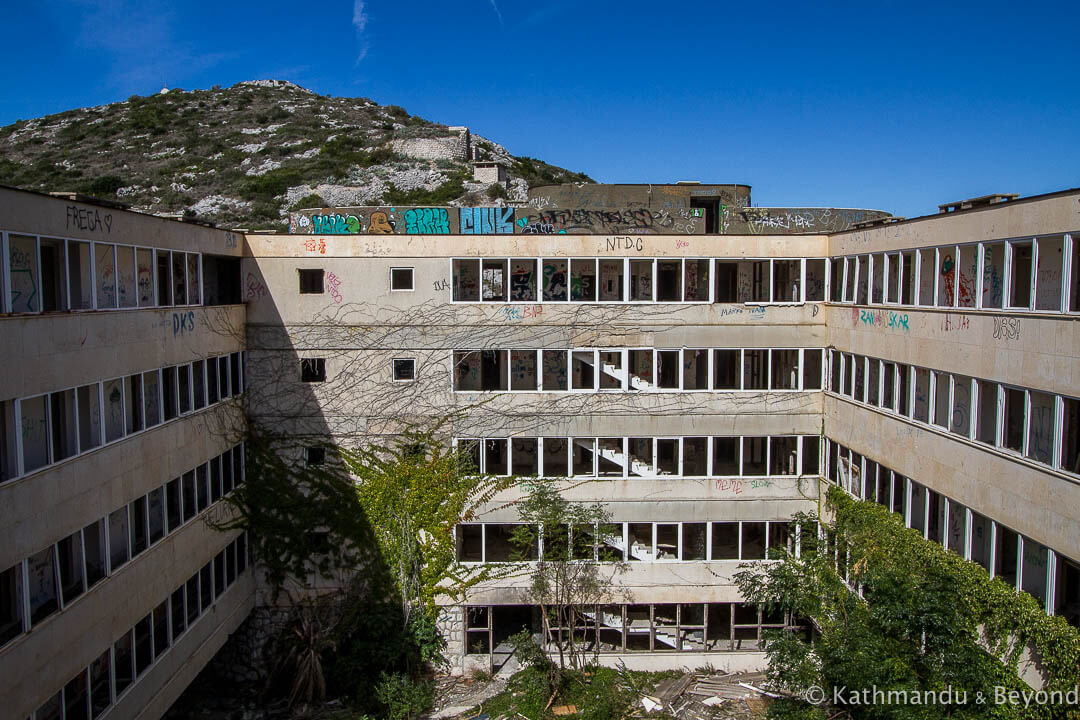
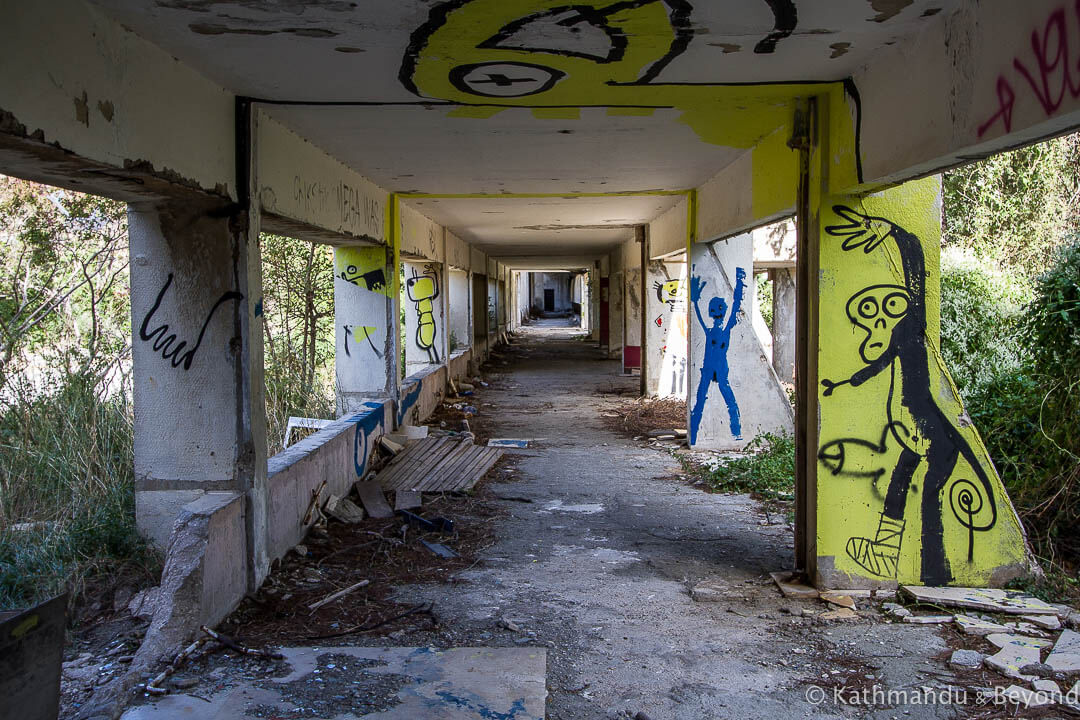
Courtyard of the Hotel Pelegrin (left) and walkway linking the Hotel Pelegrin with the Hotel Kupari (right)
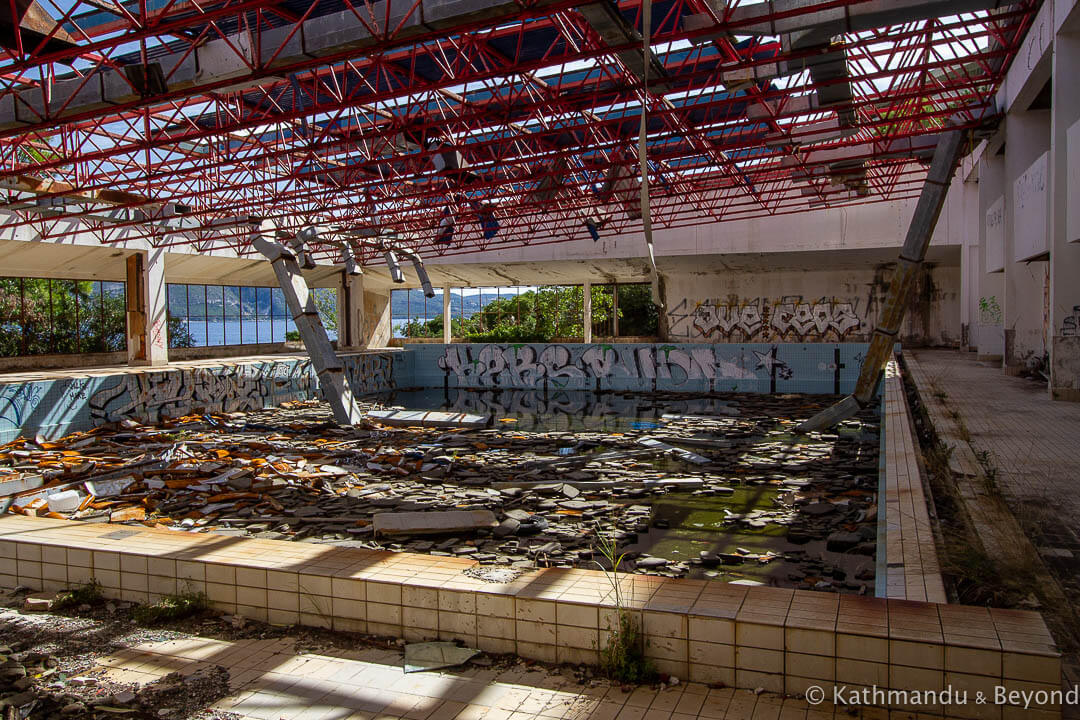 Swimming pool at the Hotel Kupari
Swimming pool at the Hotel Kupari
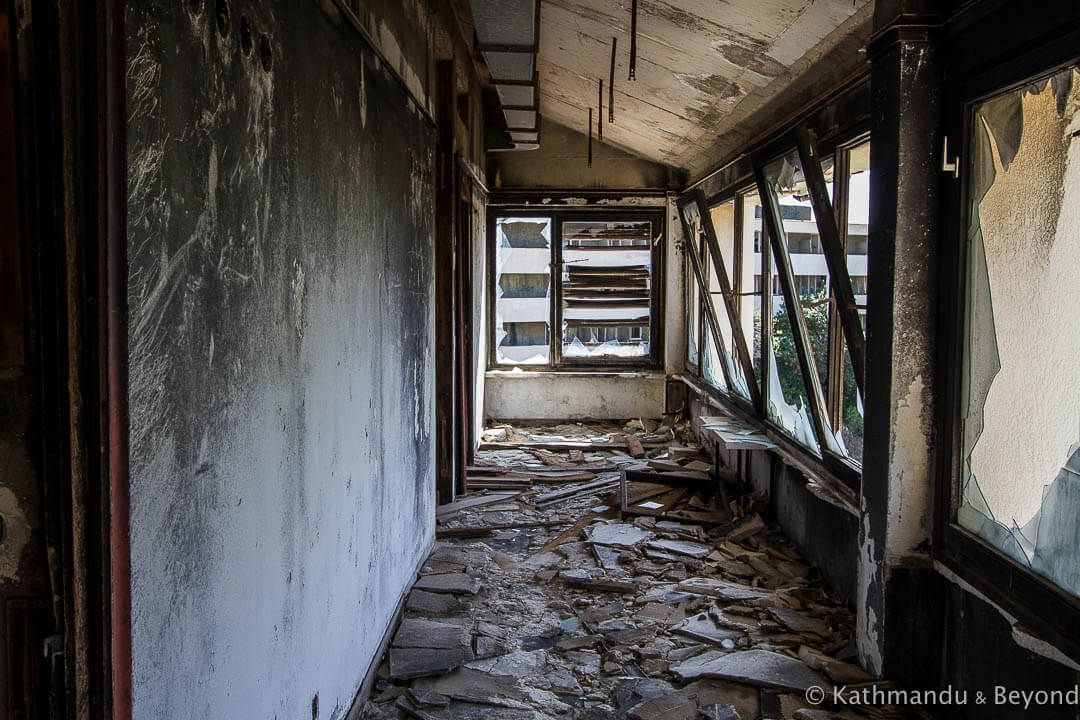 Corridor inside the Hotel Kupari. The blackened walls are as a result of the phosphorus bombs used during the war
Corridor inside the Hotel Kupari. The blackened walls are as a result of the phosphorus bombs used during the war
We purposely left the Hotel Grand until last and next made our way across the other side of the bay to the two Goričina hotels. Goričina II, which had more than double the number of beds than the original Goričina I, took us quite a while to explore and was the only hotel we went inside in which the staircase leading to the upper floors was predominately pitch-black. We persevered, however, and eventually found ourselves in bright sunshine once again, having made it up to the roof. The climb was worthwhile, however, as the view down helped put the entire resort into perspective and, after a mosey around the ground level dining area and a venture into the basement (where the disco used to be), we departed and walked the short distance to the entrance of the Hotel Grand.
The Hotel Grand was the most interesting place we explored at Kupari. Not surprisingly, given the year it was built (1920) and the fact that the Czechs had a hand in its design, the place was reminiscent of a period hotel in Eastern Europe. Once-lavish wallpaper and tiling, colonnades, sweeping staircases and palm trees in the inner courtyard were all giveaways that this almost-a-century-old hotel would have once been the most opulent place to stay on this particular stretch of the Adriatic Coast.
Even though it is smaller than all the other properties, we spent the longest amount of time in the Grand, rummaging around and checking out every detail. It was a good place to end our almost-half-a-day spent in this little corner of Dalmatia and we felt rather smug as we joined the highway once more in the knowledge that the endless camper vans and coach loads of tourists in front and behind us, and also travelling in the other direction, probably had no idea this fascinating spot even existed.
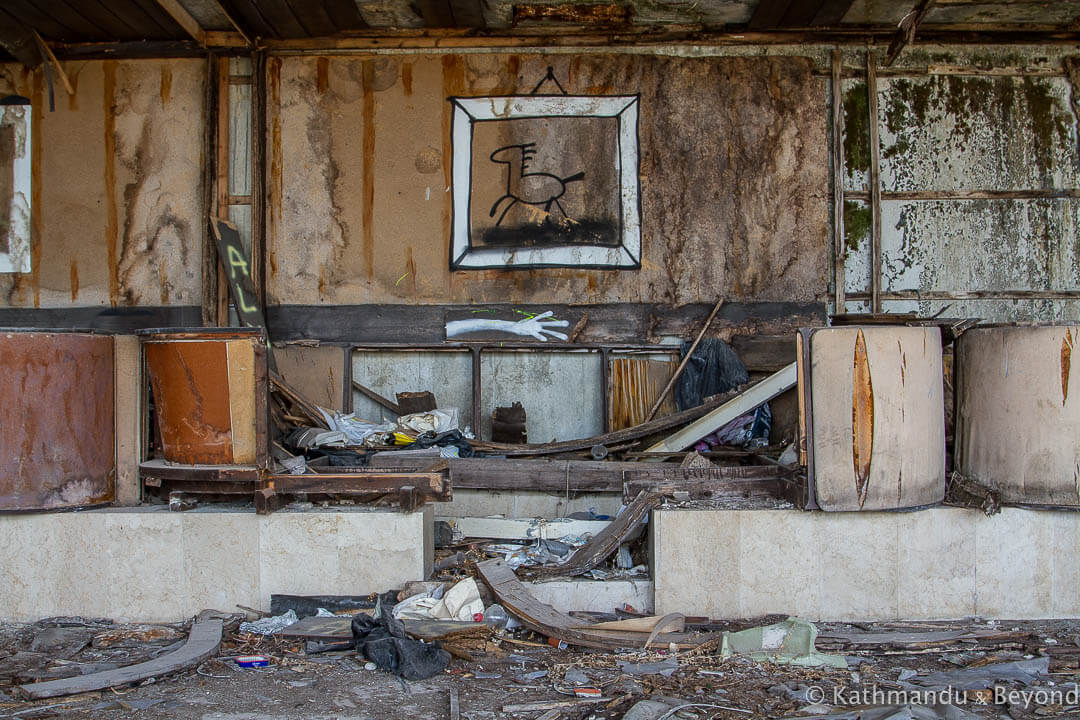 Inside the restaurant of Hotel Goričina II
Inside the restaurant of Hotel Goričina II
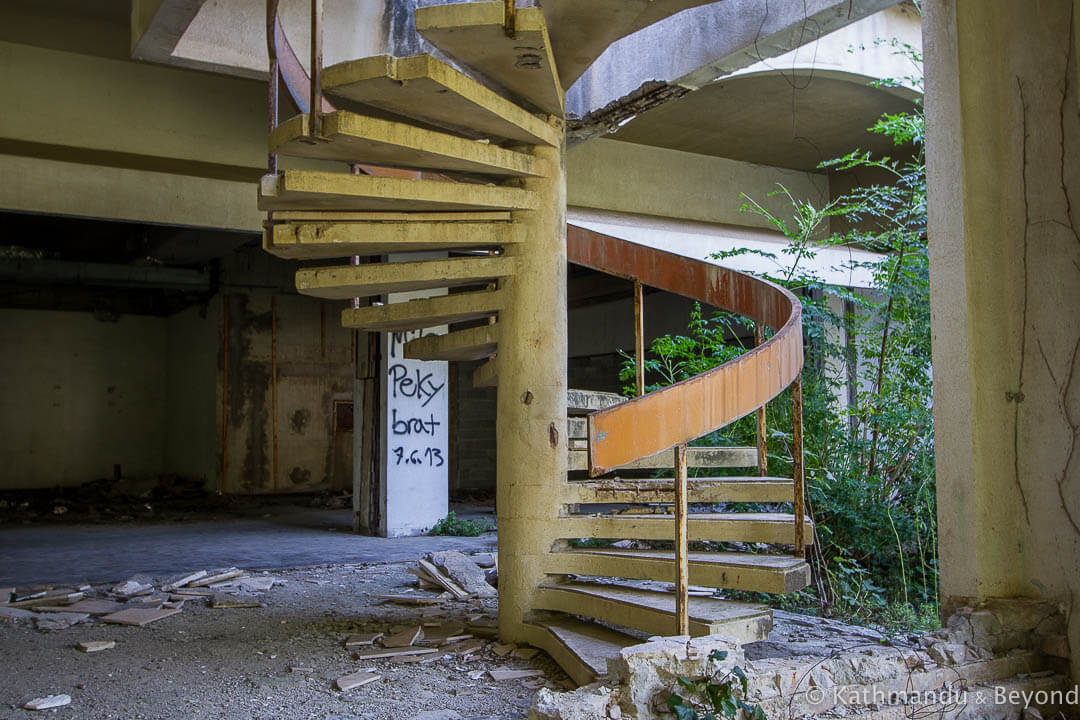
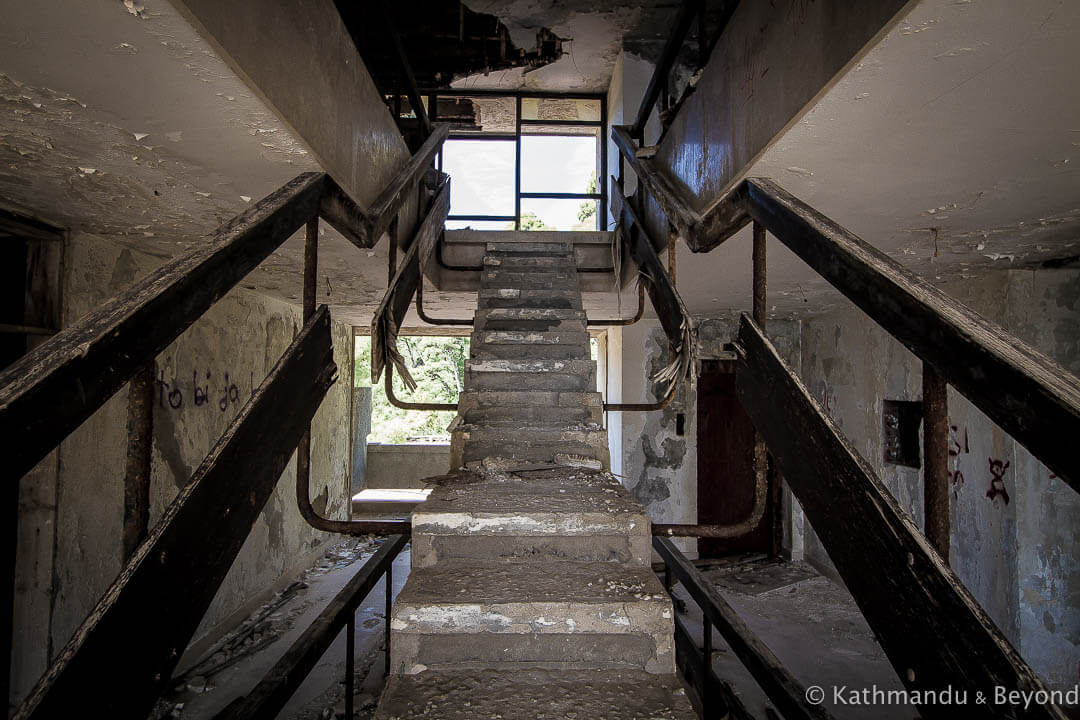
Hotel Kupari (left) and Hotel Goričina I (right)
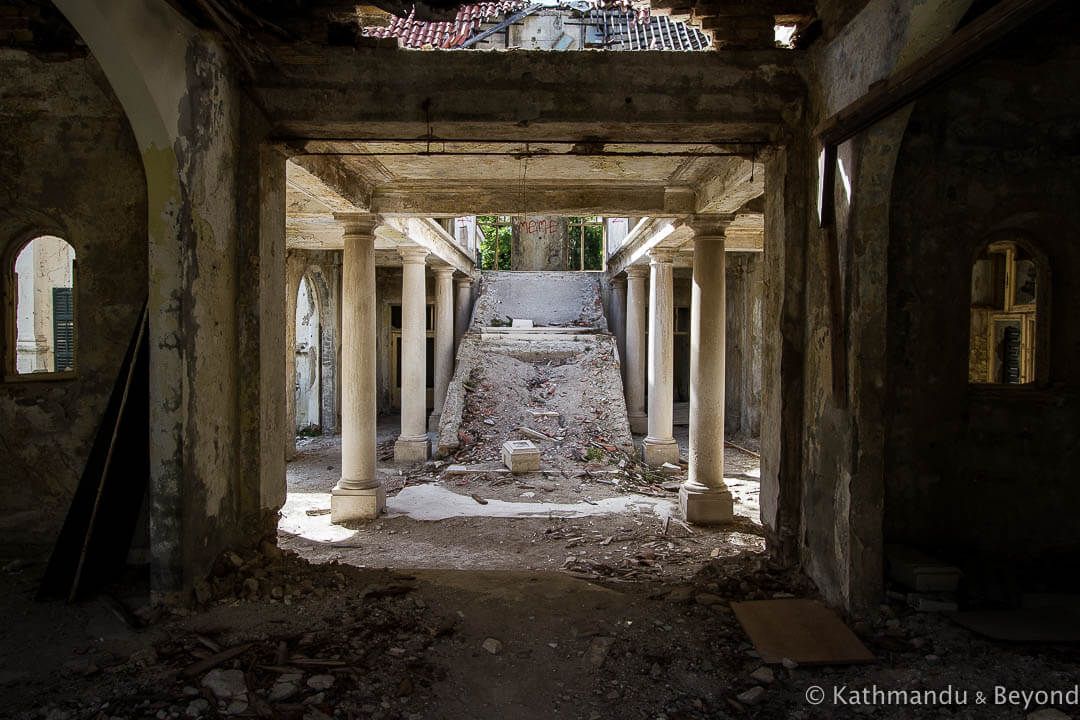 A once-grand entrance inside the Hotel Grand
A once-grand entrance inside the Hotel Grand
How to get to Kupari’s Bay of Abandoned Hotels
Any public bus running up and down highway D8, the extremely scenic road that runs from the Slovenian border via numerous cities and towns (including Dubrovnik) to the frontier with Montenegro, should be able to drop you off in Kupari near the turnoff for Župa Bay. From there, it’s a 500m walk down to the bay and the hotels.
If you’re driving yourself, the best place to park is in front of the Grand Hotel, directly opposite the beach. Parking is free. Go soon and enjoy your visit to the Bay of Abandoned Hotels.
READ MORE BLOG POSTS FEATURING ABANDONED PLACES
DO YOU ENJOY EXPLORING ABANDONED PLACES? PIN THIS POST FOR LATER…
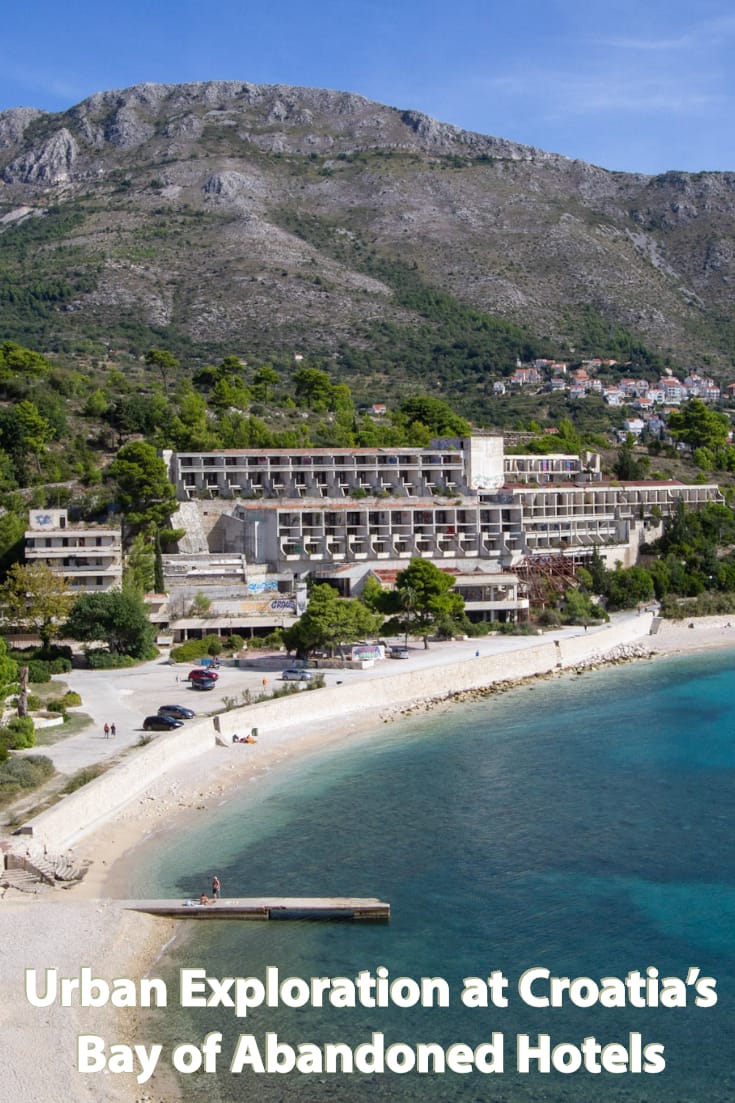
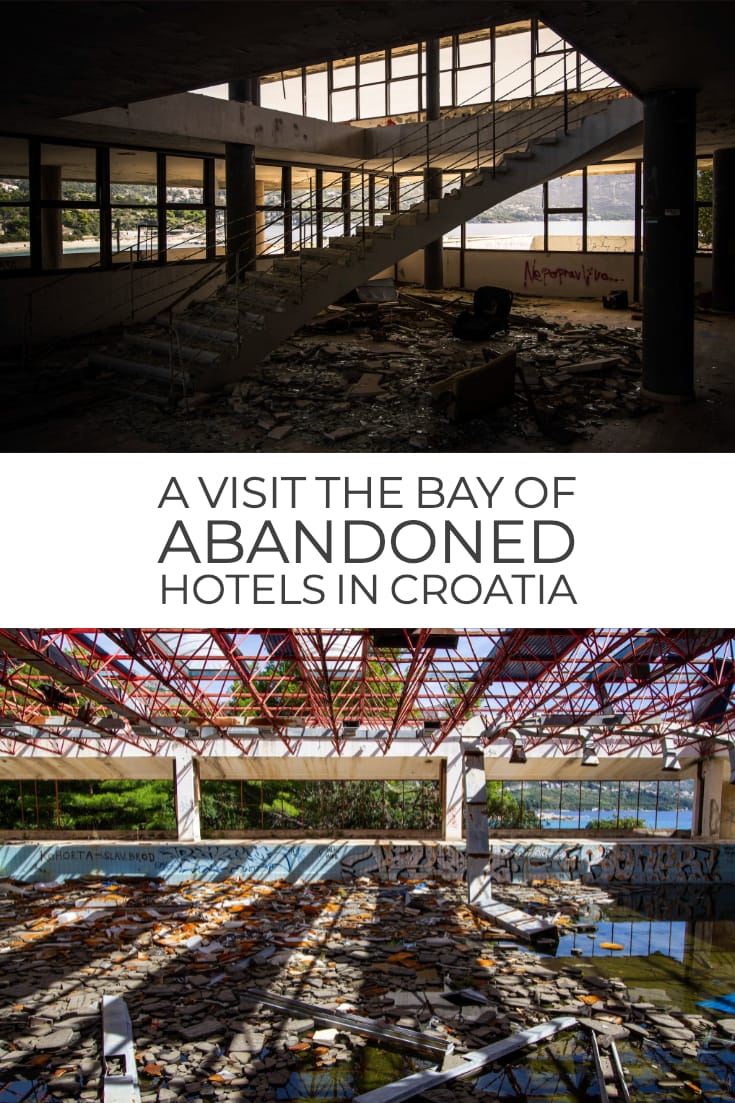
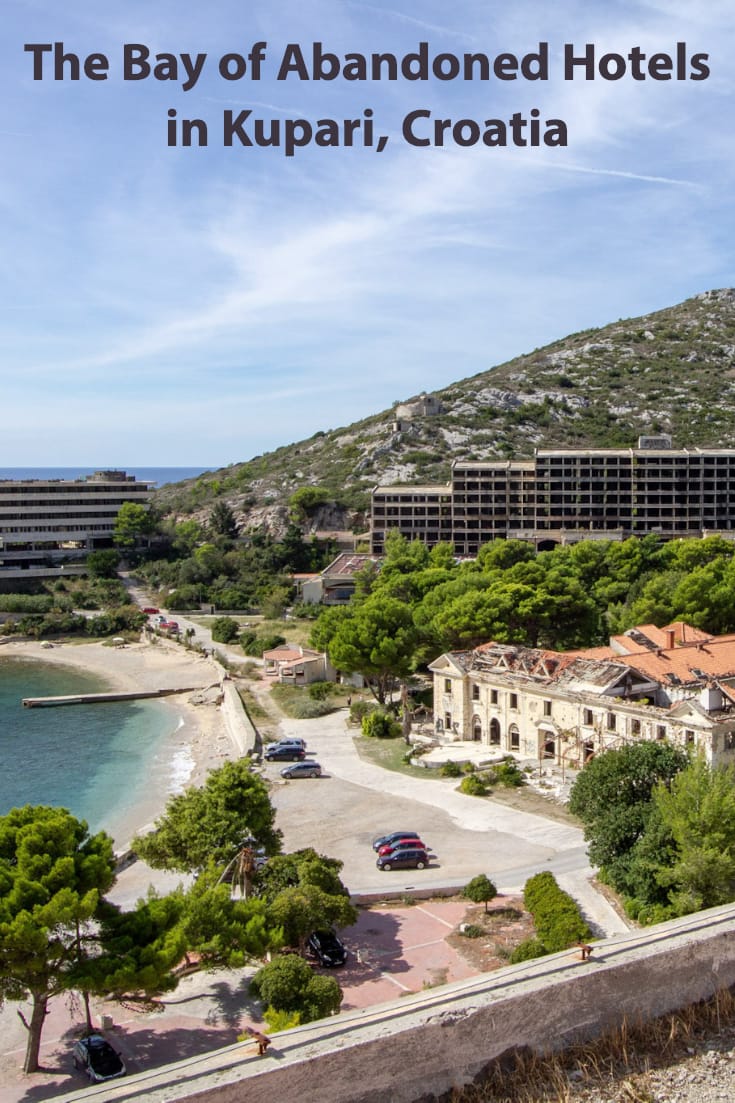

Kirsty and Mark; you find some awesome abandoned gems. Loving your photos.
Thanks Ryan! Appreciated, as always! 🙂
Staying in Mlini, and went a walk along the beach we stumbled onto this resort, it is a testamony to what a war can inflict. The contrast with Dubrovnik is obvious the walls are almost pristine showing no signs of the war, whilst these hotels show the brutality of war. If the area is to be developed then something should be combined so that the history of the place is not forgotten .
Thank you for this information it was very insightful.
Thank you, happy to hear the post provided you with a bit of additional information. You’re right – the contrast between Kupari and Dubrovnik is huge.
Out of interest, how long did it take you to walk along the beach from Mlini?
In the 90’s and early 00’s I usee to travel to Krk with my parents every year(my father went there since the 70’s) and I always wonderd why these huge hotels where there, standing empty. One was right of the shore I remeber, and I climbed into its doctors office, back then it was still filled with filing cabinets and other furniture, paperwork everywhere. A local told me years later that the high brass used to stay there, and that was why noone ever wanted to touch those properties.
I wonder if its all still there.
Very interesting, I’m wondering if you are describing the Haludovo Palace Hotel in Malinska. It’s located on the beach and was constructed in the late 1960s, early 1970s. We have been to it but not written about it yet. We visited in September just gone. If you are on Facebook have a look at the link below to see if you recognise it? I was also wondering if you had any old photos you would be willing to let us have a look at? It is always fascinating to see then and now images of an abandoned property!
https://www.facebook.com/KathmanduandBeyond/posts/1921400398006313
Great post. I went there in 2021 and it’s still the same. Its a beautiful place. Seems a wasted opportunity. There we are. I was a bit worried that they may fall down while I was wandering around. Health and safety legislation not quite so important in Croatia it seems!
Had a walk around the bay today, it’s still the same as when the article above was written, a low budget war movie was being shot today.
If a few hotel chains got hold of this bay together it would be very profitable in the long run with Dubrovnik just a few miles away.
Thanks for the update! And you are right about the bay being used for tourists visiting Dubrovnik. Pre-COVID there was a shortage of beds in the city and Kupari would be the obvious place to help alleviate the problem.
Don’t think it was a low budget film – I think it was the Kate Winslet film on war photographer Lee Miller.
cool!